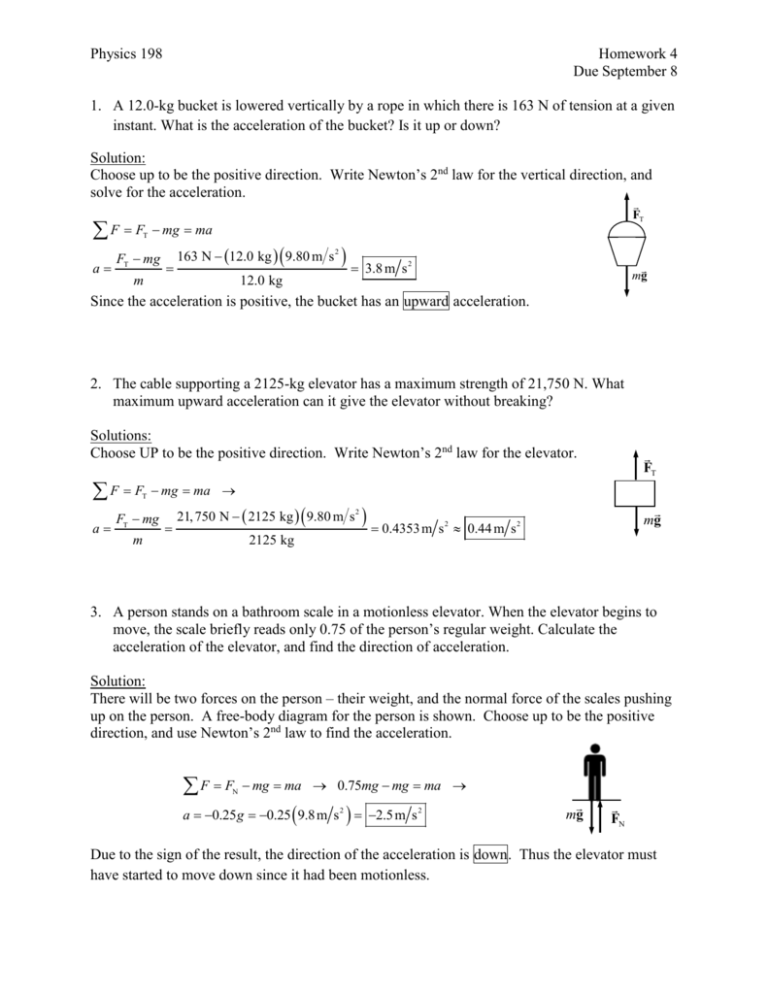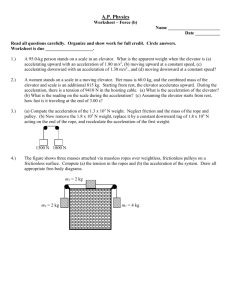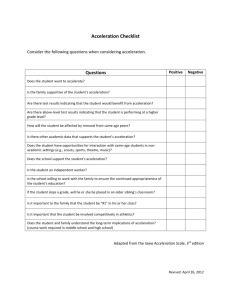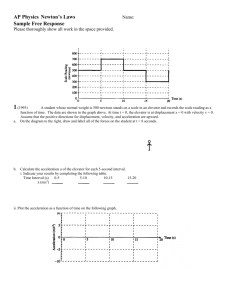hw04_solutions
advertisement

Physics 198 Homework 4 Due September 8 1. A 12.0-kg bucket is lowered vertically by a rope in which there is 163 N of tension at a given instant. What is the acceleration of the bucket? Is it up or down? Solution: Choose up to be the positive direction. Write Newton’s 2nd law for the vertical direction, and solve for the acceleration. FT F FT mg ma a FT mg m 163 N 12.0 kg 9.80 m s 2 12.0 kg 3.8 m s 2 mg Since the acceleration is positive, the bucket has an upward acceleration. 2. The cable supporting a 2125-kg elevator has a maximum strength of 21,750 N. What maximum upward acceleration can it give the elevator without breaking? Solutions: Choose UP to be the positive direction. Write Newton’s 2nd law for the elevator. F F T a FT mg ma FT mg m 21, 750 N 2125 kg 9.80 m s 2 2125 kg 0.4353 m s 2 mg 0.44 m s 2 3. A person stands on a bathroom scale in a motionless elevator. When the elevator begins to move, the scale briefly reads only 0.75 of the person’s regular weight. Calculate the acceleration of the elevator, and find the direction of acceleration. Solution: There will be two forces on the person – their weight, and the normal force of the scales pushing up on the person. A free-body diagram for the person is shown. Choose up to be the positive direction, and use Newton’s 2nd law to find the acceleration. F F N mg ma 0.75mg mg ma a 0.25 g 0.25 9.8 m s 2 2.5 m s 2 mg FN Due to the sign of the result, the direction of the acceleration is down. Thus the elevator must have started to move down since it had been motionless. Physics 198 Homework 4 Due September 8 4. The musical note A4 has a frequency of 440 Hz. Calculate the period and the angular frequency. Solution: 1 1 T 0.0023s ; 2f 2 440 Hz 2764s 1 f 440 Hz 5. A pendulum’s length is 1.0 m. Calculate frequency, period and angular frequency of the pendulum. Solution: g 1 L ; f ; T 2 L 2 f g 9.8m / s 2 3.1s -1 ; f 0.50 Hz ; T 2.0s 1.0m 6. A mass on a spring in SHM has amplitude A and period T. a) What is the total distance traveled by the mass after a time interval T? b) What is the net displacement of the mass after a time interval T? c) How long does it take for the mass to travel a total distance of 6A? Solution: a) In the time interval T (the period), the mass goes through one complete oscillation back to the starting point. The distance it covers is 4A. b) Since the initial and final positions of the mass are the same (it ends up back at its original position), then the displacement is zero. c) We have already seen that it takes one period T to travel a total distance of 4A. An additional 2A requires half a period, so the total time needed for a total distance of 6A is 1.5T. 7. A mass oscillates on a vertical spring with period T. What will happen to the period? a) If the mass is doubled. b) If the whole setup is taken to the Moon. Solution: a) The period is proportional to the square root of the mass. T 2 m / k So an increase in mass will lead to an increase in the period of motion. Period will increase 2 1.4 times. b) The period of simple harmonic motion only depends on the mass and the spring constant and does not depend on the acceleration due to gravity. By going to the Moon, the value of g has been reduced, but that does not affect the period of the oscillating mass-spring system. Physics 198 Homework 4 Due September 8 8. A swinging ideal pendulum has period T on Earth. What will happen to the period? a) If the mass is doubled? b) If amplitude is doubled? c) If the whole setup is taken to the Moon. (The acceleration due to gravity on the surface of the Moon is 1.6249 m/s2; this is about 16.6% of what we have on Earth's surface.) d) If length of the pendulum is doubled? Solution: The period of a pendulum does not depend on its mass and amplitude, but only on its length and the acceleration due to gravity: T 2 L / g . a) Period is the same (T) b) Period is the same (T) c) Period increases: TMoon 2 d) Period increases L g Moon 2 1.4 times 2 L g g 9.8 T T 2.5T g g Moon g Moon 1.6







